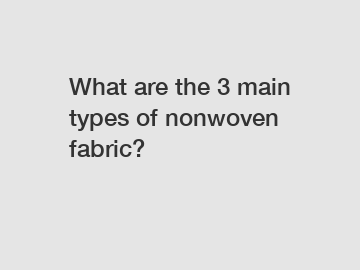What are the 3 main types of nonwoven fabric?
Nonwoven fabrics are widely used in various industries due to their versatility, cost-effectiveness, and ease of production. But what exactly are the three main types of nonwoven fabric?
The three main types of nonwoven fabric are spunbond, meltblown, and needle punched. These types differ based on their manufacturing process and end-use applications. .
Spunbond nonwoven fabric is produced by extruding filaments onto a conveyor belt, where they are then bonded together using heat, pressure, or chemicals. This process creates a fabric that is strong, durable, and resistant to tearing. Spunbond fabrics are commonly used in applications where strength and durability are essential, such as geotextiles, automotive interiors, and filtration media.

Meltblown nonwoven fabric, on the other hand, is created by extruding molten polymer fibers onto a high-speed air stream. The fibers are then collected on a belt or drum, forming a fine, web-like fabric. Meltblown fabrics have excellent filtration properties and are commonly used in medical face masks, air filters, and oil absorbents.
The third type of nonwoven fabric is needle punched. This process involves mechanically interlocking fibers by repeatedly passing barbed needles through them. Needle punched fabrics are characterized by their dimensional stability and resistance to stretching or distortion. They are commonly used in applications such as carpet backing, upholstery, and roofing materials.
The categorization of nonwoven fabrics into these three main types serves an important purpose. By understanding the different manufacturing processes and properties of each type, manufacturers can select the most suitable fabric for their specific application. For example, when designing a filtration system, meltblown fabric would be an ideal choice due to its excellent filtration efficiency. On the other hand, if strength and durability are the primary requirements, spunbond fabrics would be a better option.
Furthermore, the categorization of nonwoven fabrics helps streamline the production process. Manufacturers can focus their resources and expertise on improving and optimizing the specific manufacturing techniques used for each type. This leads to increased efficiency, lower production costs, and enhanced product quality.
In conclusion, the three main types of nonwoven fabric - spunbond, meltblown, and needle punched - offer distinct properties and applications. Understanding these types allows manufacturers to make informed decisions when selecting the appropriate fabric for their specific needs. Moreover, the categorization aids in the optimization of manufacturing processes, leading to improved overall efficiency and product quality in the nonwoven industry.
If you are looking for more details, kindly visit material spunbond, Adhesive Fenestrated Surgical Drape, Double color PE film.


